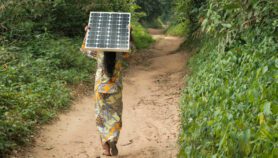By: Radhika Perrot
Send to a friend
The details you provide on this page will not be used to send unsolicited email, and will not be sold to a 3rd party. See privacy policy.
An ambitious strategy to create fuel cell products for export will need incentives and cross-government backing to bear fruit, says Radhika Perrot.
South Africa’s Department of Science & Technology (DST) has been laboriously pushing for the development of hydrogen fuel-cell technology through an ambitious research and development (R&D) strategy since 2005. Fuel cells can convert the energy produced by a chemical reaction between hydrogen and oxygen into electric power.
The strategy is ambitious because it aims to enable the export of high-value products into growing international hydrogen fuel-cell markets when there is currently almost no domestic industry or market.
The goal of dipping a toe in the waters of a fledgling and uncertain hydrogen fuel-cell technology baffled a great many sceptics. The technology is not yet commercially viable, and the prospect of hydrogen fuel cells becoming a technology of the future is still in doubt.
SPEED READ
- South Africa aims to create a fuel cell sector to diversify the economy and create jobs
- The country can use its vast platinum reserves to make fuel cell catalysts
- But the ambitious plan needs coordinated policy support from government
South Africa‘s R&D thrust was less about meeting environmental goals and more about meeting the national objective to move beyond an economic reliance on mining and mineral extraction. There is a potential payoff in investing in fuel-cell technology — but it is not without risk, and will require coordinated policies to succeed.
Growth plan
The South African government prioritised the mining industry as an economic growth trajectory in its 2010 New Growth Path [1], a move that it hopes will generate highly skilled jobs and a strong knowledge base through new industries, products and services.
The strategy has set a target of creating five million jobs by 2020 overall. And the DST has established research partnerships called centres of competences, all of which are focused on building technical know-how and a scientific base related to hydrogen fuel-cell technology.
Platinum is one of the minerals included in the strategy. It is used in catalytic converters installed to cut emissions from vehicles with internal combustion engines. South Africa is home to 75 per cent of the world’s known reserves of platinum and five similar metals with which it is commonly found, and supplies around 59 per cent of the world’s demand for these ‘platinum group metals’. The country also boasts a complex supply chain of about 50 manufacturers that make up 14 per cent of the global catalytic converter industry’s market share.
Providentially for South Africa, platinum is also used as a catalyst in hydrogen fuel cells. Platinum catalysts are a core component of proton exchange membrane fuel cells (PEMFC), a widely used hydrogen fuel-cell type for powering cars and stationary applications such as lights and telecommunication towers.
Given this, the DST has set its sights on meeting a quarter of the global demand for platinum-based catalysts for fuel cells by 2020. Achieving this will require building hydrogen fuel cell manufacturing plants, and the department is currently looking for a foreign partner to do this.
Foreign investment
But why would foreign companies want to manufacture hydrogen fuel-cells in South Africa? The country has yet to make any breakthroughs in this technology. The domestic market is weak, while regulations and policies to stimulate supply or drive demand — which fuelled growth in the country’s catalytic converter industry — are insufficient.
Another disadvantage for South Africa, and notably for the PEMFC technology, is the absence of an indigenous automobile manufacturer, which, although not essential, would have offered benefits such as cutting the time needed to develop commercial products.
In addition, South African firms that make catalytic converters are gradually losing market share to those closer to European car manufacturers. The reasons behind this — such as declining government support and investor confidence — also apply to the hydrogen fuel-cell industry.
In the face of such sticky realities on the ground, it is a risky bet for industrialists and policymakers to remain optimistic about South Africa’s future in the global automotive industry. But not taking a gamble on fuel cells would mean missing out on what could be another industrial success — as well as knowledge creation and new highly skilled jobs.
Government support
South African policymakers need to provide extensive policy support and subsidies to hydrogen fuel cell investors and manufacturers, and should nurture technology-specific programmes that will help to bring locally produced or even licensed fuel cell technologies to market.
They also need to create markets for such new energy technologies through regulations and incentives targeted at both residential and industrial energy users, such as mobile phone operators.
One policy could be to support small, local entrepreneurial firms across the future fuel-cell supply chain through tax benefits and low-interest loans.
The DST is encouraging local R&D companies to work with South African and foreign research institutions to exchange technical know-how about hydrogen fuel-cell catalysts and their components. Such industry-academic partnerships could speed up the time to commercialisation, creating further possibilities of spin-offs and job creation.
Moreover, hydrogen-based energy is not part of the Department of Energy’s (DOE) recent 20-year energy plan. The DST’s plan is focused on R&D and can do little to address issues around implementing such new technology.
This means that the DOE and the Department of Trade and Industry, whose role is to encourage competitive industries through regulation, must be equally involved to facilitate uptake. There must be agreement between government departments in the new energy technology choice and path, from R&D to commercialisation.
Radhika Perrot is a senior researcher in the Knowledge Economy and Scientific Advancement faculty at the Mapungubwe Institute for Strategic Reflection (MISTRA), Johannesburg, South Africa. MISTRA is facilitating a dialogue between policymakers and departments for the uptake of hydrogen fuel cells in South Africa. Radhika can be contacted at [email protected]
References
[1] The New Growth Path: The Framework (South African Government, 2010)













